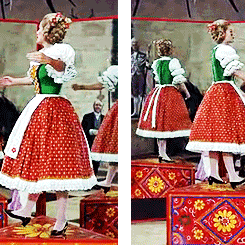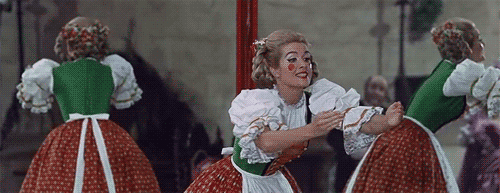
https://www.grafik.net/category/screenshot/living-doll
The ‘Doll on a Music Box’ scene from Chitty Chitty Bang Bang (1968) is one of my all-time favourite sequences in film history. This has always been a completely magical scenario for me, and in many ways set the tone for much of my own creative practice and the themes that I return to, over and over again.
Choreographed by the legendary team Mark Breaux and Dee Dee Wood (who also worked on Mary Poppins and The Sound of Music), ‘Doll on a Music Box’ sees the characters Caractacus and Truly, disguised as life-sized dolls, birthday gifts for the Baron Bomburst, created by the toymaker (played by Benny Hill). In the song and dance duet that follows, our heroes (on a mission to save the children), pretend to be clockwork doll and rag doll to entertain and distract the self-centred, cantankerous and puerile Baron and his guests. This duet for me was a formative demonstration of the relationship between the body and technology. What is the difference between human and machine (clockwork in this case)? Where are the overlaps? How does it affect being human? What does it mean for a human to pretend to be a machine or a machine to pretend to be human? The scene ends with the uncertain Baron inspecting the life-sized dolls, scrutinising their authenticity. For me this is an ‘Uncanny Valley’ moment (where technology that has become too lifelike in its human features, tips the viewer’s experience from empathic to disturbing), just before the term was actually coined by robotocist Masahiro Mori in 1970.
Today, we are in the midst of profound (and often somewhat disturbing) advancements in robotics development. There are physiologically complex patient simulations, developed by companies such as CAE Healthcare and Laerdal, embodied with physical responses, such as voice, pulse, breath and tears. Geminoids are startlingly life-like looking attempts at human mimicking robots, developed by Hiroshi Ishiguro, Director of the Intelligent Robotics Laboratory, Japan. Created as body-doubles of real models (including Ishiguro), they are imbued with realistic facial expressions, that include smile, fidget and yawn. Most recently the decidedly sinister and highly sexualised robotics artwork (Female Figure) 2014, by Jordan Wolfson, was presented within the 14 Rooms exhibition at Art Basel 2014, suggesting that even the international art market is ripe and ready for robotics. The uncanny valley lurks within all these manifestations. Creative exploration and critique of the relationship between the body and technology is now as pertinent as ever.

http://www.slideshare.net/peterbuck/win ... picsdocdoc
http://www.slideshare.net/peterbuck/win ... picsdocdocMOTION AND IMMOBILITY: In some fantasy, robots are not as mobile or as articulate as we human beings are. They move like... Well, like a bunch of clunky robots! Movements can seem stilted. Measured. They can happen with great precision and machine-like grace... or clumsiness. Immobility can denote a robot that's been shut down altogether. No power. Flat battery. Needs to be wound up or activated. An example? The one example you may hear about before any other is the 'Doll On A Music Box' wind up dance from Chitty Chitty Bang Bang. This movie inadvertently influenced the young minds of thousands, friends and neighbors. And more recently, there’s been a stage production in England featuring this dance number as well. The clockwork way in which the actress moves, with foleyed wind-up ratcheting noises is enough to reduce your average techno to happy jiggly jell-o. Consider the simple act of reaching for your coffee cup. Break that down into its individual parts: Turn head to orient vision on cup, Raise Arm, Extend Arm, Extend Fingers, Rotate hand to allow for grasping, Extand hand around cup, Close fingers around cup, Lift, and so on and so on. Breaking down movements into individual actions can seem mime-like.
http://freestyledance97.blogspot.com/20 ... dance.htmlSTART-UP & SHUT-DOWN: In this regard, the Technosexual will perceive the imagined person to be activated or deactivated in all sorts of ways. Some examples include: In the classic movie Chitty Chitty Bang Bang, the character of Truly Scrumptious is dressed in an Austrian Dirndl, and made up to look like a wind-up doll. Benny Hill, the toymaker, winds her up and she proceeds to do a little song and dance number, after which she slows to a stop when her mainspring winds down.

http://www.p-synd.com/hos/asfrfaq.htmPopping is a street dance and one of the original funk styles that came from California during the late 1960s—1970s. First seen in the 1968 movie ''Chitty Chitty Bang Bang'' during a scene where actress and singer Sally Anne Howes acts as a music box doll, it is based on the technique of quickly contracting and relaxing muscles to cause a jerk in the dancer's body, referred to as a pop or a hit. This is done continuously to the rhythm of a song in combination with various movements and poses.[1]

Chitty-Chitty Bang-Bang - Yes, the kid's film. Sally Ann Howe masquerades as a wind-up music box doll, doing a VERY nice mechanical song number, even with sounds effects as she moves.